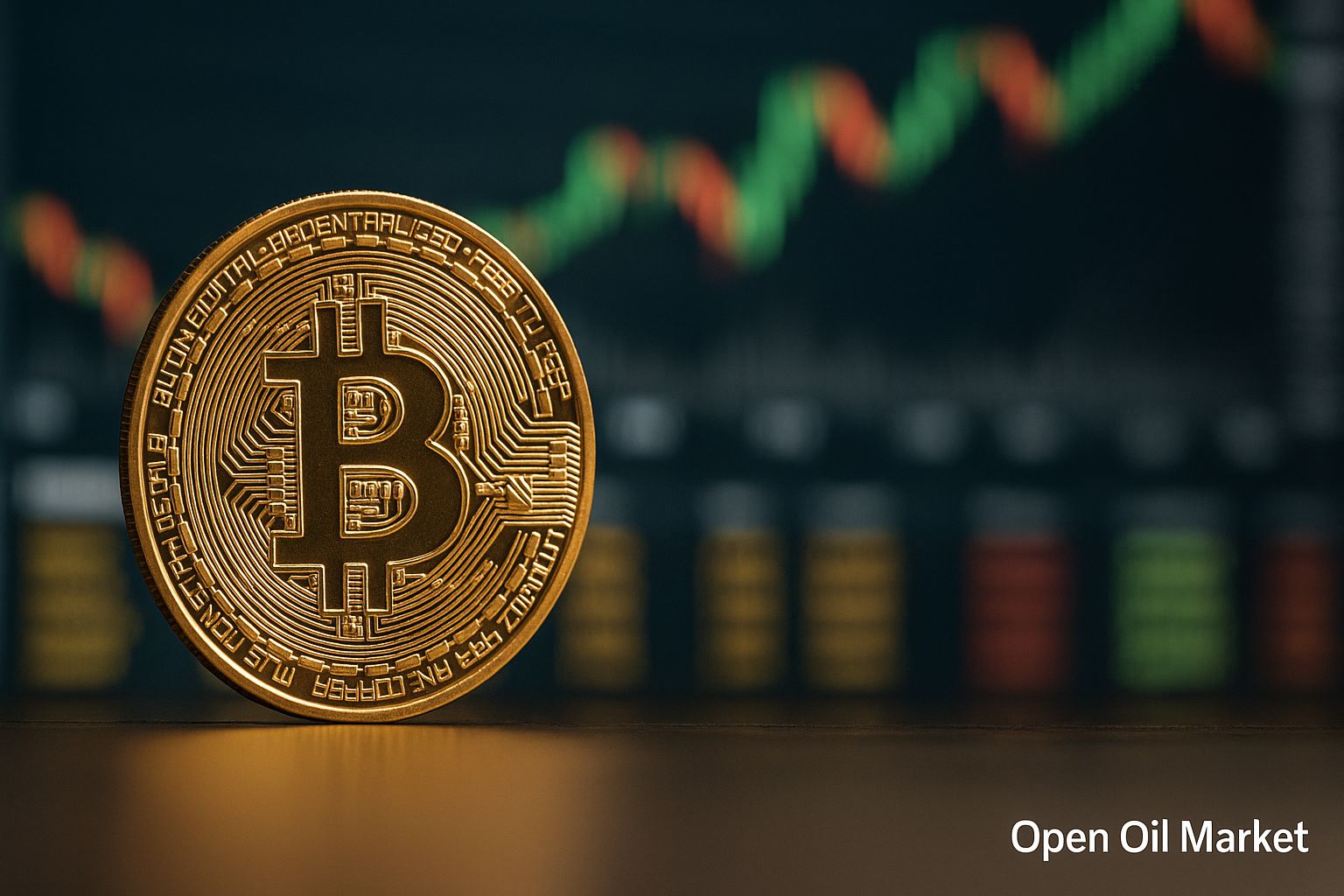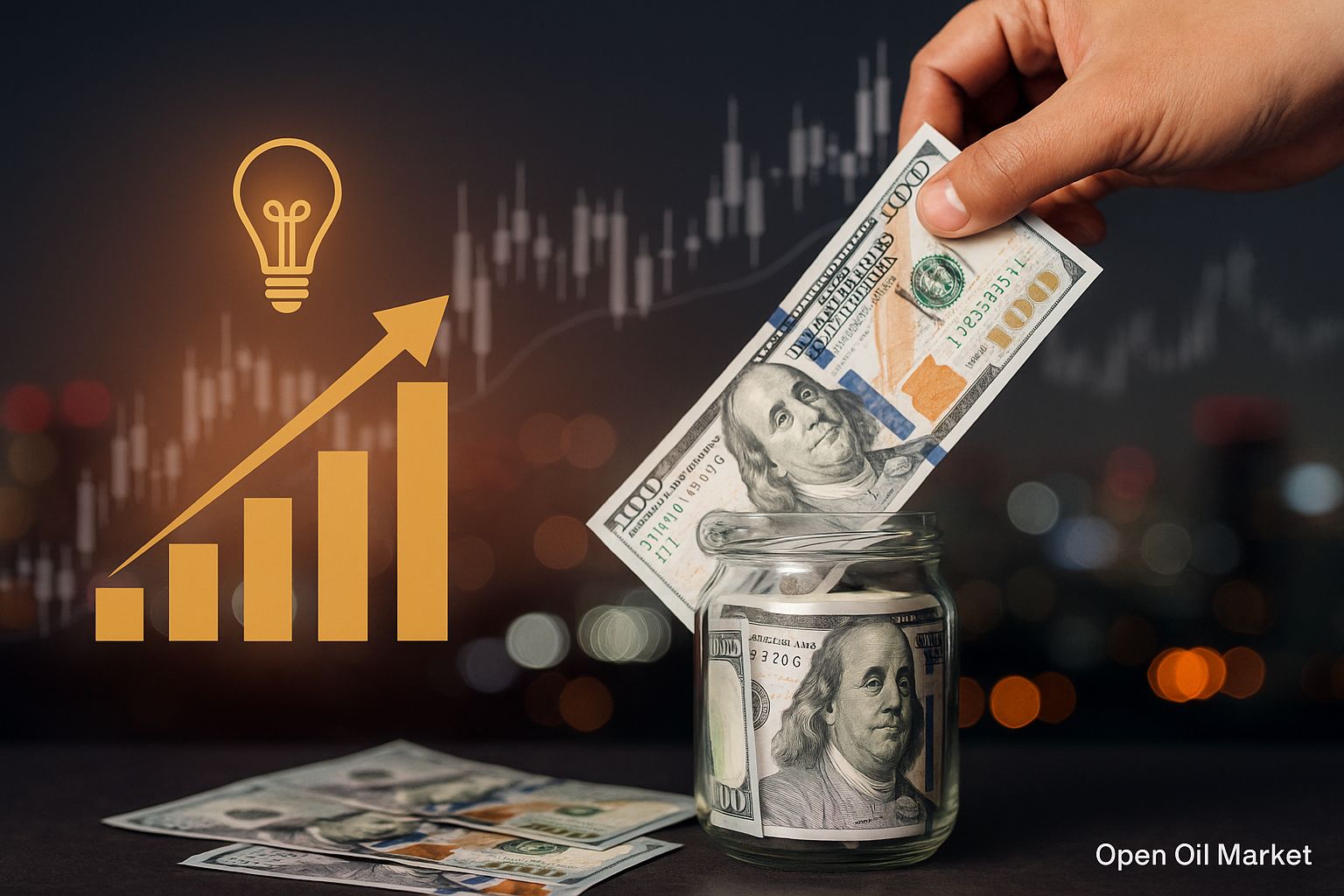
Current Cryptocurrency News as of August 13, 2025: Bitcoin Approaches Historic High, Ethereum Attracts Record Institutional Capital, Regulators Ease Stance in the US, Europe, and Asia, Market Overview of Top 10 Cryptocurrencies and Investor Sentiment.
The cryptocurrency market continues to trade at peak levels following an impressive rally, displaying a combination of stability and growth. Investors remain cautiously optimistic amidst favorable macroeconomic signals and an ongoing influx of institutional money into the sector. In focus—a renewed attempt by Bitcoin to break through its historic high, increasing interest in Ethereum from major players (record inflows into ETFs and funds), and the softening stance of regulators worldwide, which enhances market confidence as of August 13, 2025.
Crypto Market: Stability at High Levels and Support from Macro Factors
Following the rapid growth of recent weeks, the cryptocurrency market holds at record high levels and shows sustainable consolidation. Bitcoin and major altcoins trade close to their peak values, while episodic profit-taking briefly interrupts the overall upward trend. The total market capitalization of digital assets hovers around historic highs (approximately $4 trillion)—evidence of renewed mass interest from investors in cryptocurrencies. Local corrections amid previous growth are seen as a healthy phenomenon: such a breather solidifies a solid base before the potential next phase of ascent.
External economic conditions positively influence market sentiment. Recently published inflation data in the US indicated moderate price growth (around +0.2% for July), strengthening expectations of an imminent reduction in the Fed's interest rates this fall. The absence of negative surprises and hints at monetary policy easing stimulate interest in risk assets, including cryptocurrencies. Geopolitical uncertainty and trade disputes persist; however, their impact is mitigated by optimism regarding central bank actions. Consequently, the crypto market demonstrates a rare combination of high growth rates and relative stability, reflecting its gradual maturation and the growing role of institutional capital in price support.
Bitcoin: Attempt to Break Record High
The first cryptocurrency is once again trying to surpass its historical peak. Midweek, Bitcoin trades in the upper range—around $120,000, closely approaching its record high (~$123,000). The psychological barrier of $120,000 currently poses a hurdle for the continuation of the rally: profit-taking from some short-term traders is observed as the price approaches this level. Nevertheless, bullish sentiment prevails: major holders ("whales") continue to retain significant volumes, while institutional investors and crypto funds increase their positions, taking advantage of any pullbacks for additional purchases.
Experts note that the limited supply of BTC, combined with capital inflows from companies and investment funds, ensures a sustainable long-term bullish trend. A number of analysts on Wall Street forecast that, under favorable macro conditions, Bitcoin could set new historical highs by the end of the year. In the short term, fluctuations are possible: even after the current surge, pullbacks and periodic pauses in growth are not excluded. It is essential for investors to maintain balance: despite the dominant upward trend, the risk of sudden corrections still exists.
Specific indicators signal a prevailing degree of caution in the market. In the derivatives segment, there is heightened demand for protective "put" options with strikes around $95,000–$100,000, indicating that some traders continue to hedge against the risk of BTC's possible decline below $100,000 in the near future. Additionally, last week saw a slight outflow of funds (approximately $200 million) from American Bitcoin ETFs against the backdrop of general market economic concerns. However, these precautionary measures have not led to a significant drop in price—demand from long-term investors remains sufficient to absorb the selling. The presence of sustained interest alongside risk hedging speaks to a solid market foundation: even partial withdrawals do not undermine Bitcoin's current stability.
Ethereum: Record Capital Inflow and Strengthening Positions
Ethereum (ETH), the second-largest cryptocurrency by market capitalization, continues to strengthen at multi-year highs. The ETH price hovers around $4,300–$4,400, representing the highest level since 2021. Recently, Ethereum once again tested its peaks—in early August, the price reached ~$4,300, and while the historical peak (~$4,800) remains unbroken due to partial profit-taking, the overall trend remains distinctly bullish. The fundamental factors for Ethereum significantly improve: substantial institutional capital influx occurs in the market. For the first time in history, the daily volume of investments in Ethereum-based ETFs exceeded $1 billion—this record capital influx indicates that more significant investors consider ETH a necessary asset alongside Bitcoin.
One of the key factors attracting Ethereum to larger players is the ability to earn passive income through staking. Unlike Bitcoin, which profits solely from price appreciation, Ethereum allows coin holders to partake in transaction verification and receive rewards (~3-5% annually) for maintaining the network. This combination of growth potential and yield positions Ethereum as a kind of "digital oil" for the crypto industry—a fundamental resource for decentralized finance (DeFi), NFT platforms, and a multitude of blockchain services. Due to this status, interest from corporations steadily rises: the total ETH reserves on the balance sheets of public companies now exceed 1 million coins. The network activity of Ethereum also reaches new heights: in August, the daily number of transactions consistently held above 2 million, reflecting the vigorous development of DeFi protocols, NFT marketplaces, and corporate applications built on Ethereum.
XRP: Consolidation at Multi-Year Peaks
The XRP token from Ripple remains among the market leaders, sustaining positions gained over recent time. XRP's price has stabilized around $3+, a level not seen since late 2018. The rapid price increase in recent weeks resulted from major legal victories for Ripple: a US court ruling confirmed that secondary sales of XRP do not constitute securities, alleviating significant regulatory uncertainty surrounding the asset. Moreover, the prolonged court battle with the SEC was effectively concluded last week—the Commission waived further appeals, maintaining the agreed settlement of $125 million, thus putting an end to one of the industry's most high-profile cases. The final resolution of XRP's status has removed a long-standing "Damocles sword" from the market, which supports positive investor sentiment.
With the improvement of the legal backdrop, XRP has acquired new growth points. The softening stance of regulators has opened the possibility for the launch of exchange-traded investment products based on major altcoins, including XRP. Analysts believe that the first ETFs or ETNs providing exposure to XRP could be proposed as early as this fall, provided that the appropriate derivative markets and final regulatory approvals are in place. XRP is at a pivotal point: the emergence of stock products and the definitive removal of questions from authorities can provide the token with a new growth impetus, while delays in decisions will limit the enthusiasm of some investors. However, at present, institutional interest in XRP remains robust—many significant players include it in portfolio diversification, considering the success of the Ripple ecosystem in international payments.
XRP's recognition expands into global capital markets. In Japan, financial conglomerate SBI Holdings has submitted an application to launch a unique exchange-traded fund that would combine exposure to both cryptocurrencies—Bitcoin and XRP. If approved, this ETF will be the first of its kind and will emphasize XRP's growing status as a fully-fledged investment instrument on regulated platforms. Such a move could attract additional institutional capital to the token and enhance trust in XRP among conservative investors, further solidifying XRP's market positions.
Other Major Altcoins: Mixed Dynamics
In the segment of other major altcoins, varied movement is observed: some projects continue to grow on a wave of positive news, while others temporarily stagnate. The top 10 by market capitalization (besides BTC, ETH, and XRP) include several popular cryptocurrencies:
- Binance Coin (BNB): The native token of the largest cryptocurrency exchange Binance maintains high capitalization positions. BNB demonstrates relative stability amid the overall bullish market, although the Binance ecosystem is under close regulatory scrutiny. The coin is widely used for transaction fee payments and in DeFi projects on Binance Smart Chain, supporting its demand.
- Cardano (ADA): The smart contract platform, grounded in research and development, shows moderate dynamics. ADA remains in the top ten thanks to a solid community and consistent technical upgrades to the network (recent upgrades improved scalability and functionality of the blockchain). Investors view Cardano as a long-term project, although short-term volatility in its price persists.
- Solana (SOL): The high-speed blockchain, which faced significant challenges in 2022–2023, has restored trust among some investors. SOL remains among the largest altcoins, and its technology renews the attention of traditional businesses: for instance, Visa recently added Solana to its list of supported networks for stablecoin payments. Solana is expected to attract additional capital inflows if crypto-ETFs are approved in the US.
- Dogecoin (DOGE): The most well-known "meme" cryptocurrency continues to rank in the top ten, although its price has stabilized recently. The dynamics of DOGE’s price are still largely influenced by community sentiments and media mentions. The inflationary issuance model restricts long-term price growth, but the coin remains popular as a "gateway" asset for newcomers and a subject of speculation during news hype spikes.
- Tron (TRX): The blockchain platform focused on the entertainment industry and decentralized applications has strengthened its positions, entering the top ten largest coins. This achievement results from the active expansion of the Tron stablecoin protocol and the development of DeFi products built on it. Tron’s management recently announced plans to raise up to $1 billion to buy back additional TRX tokens into its corporate reserve—such a step indicates the founders' confidence in the long-term value of their asset and aims to support price stability.
Regulation: Easing Policy in Key Jurisdictions
Recent weeks have witnessed pivotal changes in cryptocurrency regulation across major global markets:
- US: A comprehensive law regulating digital assets has been passed at the federal level for the first time. President Donald Trump signed the GENIUS Act, establishing strict requirements for the issuance and backing of stablecoins (coins pegged to fiat currencies like Tether (USDT) or USD Coin (USDC)). The law mandates issuers to maintain 100% reserve backing for issued coins and adhere to high financial transparency, laying the groundwork for a sustainable market of stablecoins worth ~$250 billion. Concurrently, the Securities and Exchange Commission (SEC) launched the "Project Crypto"—a package of reforms to adapt financial rules to crypto assets. The regulator notably softens its approach: it has been announced that most cryptocurrencies will not be classified as securities, and temporary "safe harbors" are introduced for new projects (ICOs, airdrops, etc.), simplifying the launch of innovations. Additionally, in partnership with the Commodity Futures Trading Commission (CFTC), spot trading of cryptocurrencies is allowed on licensed exchanges alongside futures contracts. Notably, the SEC, under new leadership, has dropped several lawsuits, including those against major exchanges (Coinbase, Binance, etc.), signifying a shift from a "regulation through enforcement" strategy to constructive collaboration with the industry. All these steps indicate a more lenient US policy towards the crypto industry and a desire to bring digital asset trading from offshore into the legal realm of America.
- Hong Kong: As of August 1, a stablecoin law has come into effect, introducing a licensing system for stablecoin issuers under the supervision of the Hong Kong Monetary Authority (HKMA). Companies issuing stablecoins are required to comply with stringent requirements—from 100% reserve backing of all issued tokens to regular financial reporting to the regulator. Hong Kong actively positions itself as Asia's crypto hub, offering clear rules for business while simultaneously protecting investor rights. The new regulatory framework aims to attract crypto companies looking to operate legally and transparently in the region.
- European Union: The EU continues the phased implementation of the comprehensive regulation MiCA (Markets in Crypto-Assets), which establishes unified rules for the circulation of crypto assets and stablecoins across all eurozone countries. MiCA introduces registration and disclosure requirements for crypto service providers, as well as consumer protection measures and anti-money laundering efforts. The European Union strives to strike a balance between fostering innovation and managing risks to ensure cryptocurrencies are smoothly integrated into the financial system. The first licenses under MiCA are expected in 2024, but the market is preemptively adapting: the European crypto industry is moving towards greater transparency and legitimacy.
- United Kingdom: The Financial Conduct Authority (FCA) has officially announced that, starting October 8, 2025, retail investors will be allowed to invest in exchange-traded notes linked to cryptocurrencies (e.g., ETNs on Bitcoin and Ethereum). With this decision, the UK essentially lifts the ban on selling crypto derivatives to unqualified market participants that has been in place since 2021, confirming London's intention to solidify its role as a crypto-friendly financial hub. New rules will still introduce some investor protection measures; however, the overall direction of British authorities is shifting towards supporting blockchain innovations and competing for a leading position in the European crypto finance landscape.
- El Salvador: Continuing its progressive crypto agenda, the government of El Salvador has passed a law allowing licensed investment banks (with capital over $50 million) to hold Bitcoin on their balance sheets and provide services involving cryptocurrencies to institutional clients. This measure further integrates traditional finance and decentralized crypto tools, enhancing institutional participation in the market. El Salvador strengthens its position as an innovator in fintech, betting on the convergence of the banking sector with the cryptocurrency market.
Traditional Finance: Betting on Cryptocurrencies
- Visa: The payment giant continues to expand its presence in the crypto economy. The company announced the integration of new stablecoins and blockchain networks into its global payment system. Specifically, Visa now supports transactions in PayPal USD (PYUSD) and Global Dollar (USDG) stablecoins, as well as added compatibility with the Stellar and Avalanche networks alongside previously integrated Ethereum and Solana. Thus, Visa is building a multi-currency and multi-network payment infrastructure that allows banks and fintech companies to settle transactions in stablecoins swiftly and with minimal costs. This step reinforces Visa's position as a link between traditional finance and the crypto world.
- PayPal: One of the largest payment platforms has launched a new service, "Pay with Crypto", allowing tens of millions of merchants to accept payments in more than 100 different cryptocurrencies. Buyers can now pay with Bitcoins, Ethers, Litecoins, and other coins through linked crypto wallets (including third-party wallets, such as MetaMask or Coinbase Wallet), with sellers receiving revenue in stable fiat currency. The "crypto-to-fiat" conversion occurs instantly using PayPal's stablecoin PYUSD, minimizing volatility risks for businesses. Furthermore, PayPal has set a reduced fee of 0.99% on such transactions (lower than typical credit card fees), encouraging small and medium-sized businesses to transition to crypto payments. This initiative simplifies international e-commerce and reduces costs, promoting the use of cryptocurrencies in mainstream commercial transactions.
- Banking Sector: Following the introduction of relevant crypto legislation in the US, there has been noticeable growth in interest in stablecoins from traditional banks. Several American banks are exploring the possibility of issuing their own "digital dollars" or implementing blockchain solutions to accelerate international transactions. Concurrently, major asset management companies (BlackRock, Fidelity, etc.) continue to advocate for the launch of cryptocurrency exchange-traded funds, increasingly bridging the gap between the digital asset market and the stock market. As a result, boundaries between traditional finance and cryptocurrencies gradually blur: digital assets cease to be a niche experiment and become an integral part of the global financial ecosystem.
Crypto Industry: IPOs, Investments, and Corporate Strategies
- Coinbase Challenges: The largest American cryptocurrency exchange is experiencing a decline in trading activity and revenue amidst the recent market surge. Investment bank Compass Point downgraded Coinbase's stock to "sell," pointing out the slowdown in new user influx and the rise of competition (including from decentralized platforms). An additional challenge is the growth of stablecoins and DeFi services, attracting liquidity away from centralized exchanges. In response, Coinbase is striving to adapt: the exchange has announced the launch of a trading feature in its app through DeFi aggregators, allowing clients to exchange tokens directly on the Base network without fees. This move indicates that even industry leaders must change in the face of growing popularity for Web3 solutions.
- Corporate Reserves: An increasing number of public companies are incorporating crypto assets into their treasury reserves. In addition to investments in Bitcoin, accumulating Ethereum is gaining momentum—according to reports, companies collectively hold ETH worth billions of dollars, attracted by its functionality and staking profitability. Concurrently, blockchain projects themselves are engaging in buybacks of their tokens: for instance, the Tron management announced plans to raise up to $1 billion to bolster its treasury reserves of TRX tokens. This initiative aims to support price stability and demonstrates the founders' confidence in the long-term growth of their tokens' value.
- Outside the IT Sector: The strategy of crypto accumulation is being adopted by companies in traditional sectors of the economy. This week, several examples have drawn attention: an American electronics manufacturer raised ~$500 million specifically for establishing a reserve in BNB tokens, while a pharmaceutical corporation reported an investment of $110 million in Litecoin. These cases demonstrate that the adoption of cryptocurrencies is extending beyond the IT industry—representatives from various fields view digital assets as a strategic reserve. Such steps further legitimize cryptocurrencies in the eyes of the general public and create additional long-term demand in the market.
- Alternative Tokens: Besides market leaders, less prominent projects also attract capital when they present strong news. In recent days, sharp price increases have been noted in certain second-tier altcoins: for example, the token of one blockchain startup surged nearly threefold following the project's migration to a new Base-level network, while another coin gained over 60% due to its listing on a major exchange. Although such spikes are localized, they indicate that certain investors still have a high-risk appetite and the market is ready to react vigorously to technological innovations.
Market Prospects: Investor Expectations
Mid-August brought a brief respite for the crypto market, followed by another growth round. Ahead lies a series of factors capable of determining the further market dynamics. Analysts agree that recent pauses were technical in nature: profit-taking after the rally allowed the market to cool; such a breather typically precedes the next stage of ascent. If the global economy continues to provide positive signals—inflation slows down, and major central banks ease their rhetoric—investors may actively return to risk assets, including cryptocurrencies.
Industry events will also play a crucial role in shaping the trend. The recent final resolution surrounding XRP has removed a significant uncertain factor, and the expected launch of the first exchange-traded funds focused on major altcoins (such as Solana, XRP, etc.), along with the long-awaited approval of spot Bitcoin ETFs in the US, could substantially strengthen market confidence. Additional influence will stem from the realization of declared institutional initiatives—from launching new crypto funds to integrating stablecoins into banking transactions. If events unfold favorably, experts do not rule out that by the end of 2025, Bitcoin and several leading altcoins will set new historic highs, once again confirming the status of cryptocurrencies as one of the most dynamic and appealing areas for investment.
For now, many investors prefer a wait-and-see approach. The market is consolidating at a high level, but fundamental underpinnings for new growth remain, making digital assets an essential part of a diversified investment portfolio—despite periodic pauses and corrections.
Cryptocurrency Market as of the Morning of August 13, 2025
Major Cryptocurrency Prices:
- Bitcoin (BTC): $119,500
- Ethereum (ETH): $4,400
- XRP (XRP): $3.12
- BNB (BNB): $820
- Solana (SOL): $180
- Tether (USDT): ₽78.50
Market Indicators:
- Cryptocurrency Market Capitalization: $4.02 trillion
- Bitcoin Dominance: 60.1%
- Fear and Greed Index: 70 (Greed)
Daily Change Leaders:
- Gainer: Bonk (BONK) — +7%
- Loser: Fartcoin (FARTCOIN) — -17%
Analysis: The cryptocurrency market maintains a capitalization close to its record, with Bitcoin's dominance slightly above 60%. The sentiment index remains in the "greed" zone, indicating potential overheating and the likelihood of a short-term correction. Individual altcoins continue to display significant volatility: sharp spikes and drops in smaller tokens reflect heightened speculative activity in this market segment.




